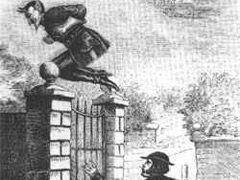


There are fairy tales, myths and folk tales galore set in London, from the heart-warming to rather more worrying diabolical apparitions and tales of human sacrifice. But like with the all the best fiction, though inspired by real life, these are the stories where the authors gave free rein to their most eccentric fantasies, spurred on by the fascinating city they lived in.
A Christmas Carol
Charles Dickens wrote A Christmas Carol as a celebration of Christmas at a time when London was fiercely divided between very rich and very poor. There has been no greater commentator on the darkness of the Victorian era than Dickens, and this fairy tale paints a grim picture of the city, drawn from his own personal experience. Despite this, it is also a story filled with warmth and optimism, as the main character, the avaricious Ebenezer Scrooge, is given the chance to live a happy life once he starts to treat those around him with generosity. In the story, Scrooge is visited by the Ghosts of Christmas Past, Present and Future, with each one showing him a different vision – in particular the latter who presents him with the possibility of a lonely life and unattended grave should he not buck up his ideas and start showing kindness to those who need it. Scrooge is loosely based on the author’s own father, and the book’s scenes of impoverished families are lifted directly from what Dickens himself witnessed throughout his life in the capital. The book has never been out of print, and phrases like “bah, humbug!”, “scrooge” and “merry Christmas” have been forever imprinted into the English lexicon.
\n\nDick Whittington and His Cat
Although loosely inspired by Richard Whittington, Lord Mayor of London from 1397 to 1420, the Dick Whittington of this fairy tale bears little resemblance to the real man. The story has Dick as a poor orphan who travels to London upon hearing that the streets are paved with gold. Of course once he arrives he finds nothing more than filthy pavements (although minus kebab boxes and chewing gum, so probably a tad cleaner than they are today). He is taken in by a rich businessman, and he promptly buys a cat to drive away the rats that are infesting his room. Although it’s a sweet story, it does lack the moral of many other fairy tales, as Dick is seemingly extremely lucky when his rat-catching cat is sold for a large quantity of gold, making him rich; he is then elected Mayor of London three times. Archway’s Whittington Hospital is named after him, and a statue of his cat stands proudly outside.
Peter Pan
The story of Peter Pan, originally written as a play by J.M. Barrie, deals with fantasy rather than social themes, as Peter persuades Wendy and her brothers to leave their comfortable family home in Bloomsbury and fly to Neverland with him. There they encounter various exaggerated characters such as the evil Captain Hook, the mischievous fairy Tinker Bell and the enigmatic Indian princess Tiger Lily. Peter’s gang, the Lost Boys, are a group of little boys who fell out of their prams whilst their mothers were taking them through Kensington Gardens. They became lost forever more in the London park, and today there is a bronze statue here of the cheeky boy who refused to grow up.
\n\nSpring Heeled-Jack
More sinister is the tale of Spring-heeled Jack. Sightings of this mysterious figure were first reported in the 1830s. He seemed to have a penchant for attacking young women, who claimed he had metallic claws, could breathe fire, and sported a long cloak; some even went as far as comparing him to a bear or even the devil. Moreover, he had the ability to leap several feet in the air, hence his name. He was spotted all over London, from Hammersmith to Peckham to Limehouse; whether the result of mass hysteria or simply a clever hoax (there is a theory that he was in fact a group of aristocrats who had put a bet on scaring Londoners witless), Spring-heeled Jack became a popular fixture of newspapers, cheap theatre shows and pulp fiction of the mid-19th century, as well as daily tabloid fodder – the News of the World in particular was a keen perpetrator of the story. The character became a household name, as it was not uncommon for parents to tell their children that Spring-heeled Jack would come for them if they didn’t promptly go to sleep. Sightings became less frequent in the 1850s, although inexplicable crimes that took place for several decades later would still be attributed to him.
London Bridge Is Falling Down
While we’re on tales of a pernicious nature, have you ever wondered where the popular ‘London Bridge is Falling Down’ nursery rhyme comes from? As with most folk tales and songs there is no exactitude as to its origin, but one theory claimed that children were being sacrificed at the foot of the bridge, as apparently without this ritual the river wouldn’t take kindly to its construction and it would inevitably fall down. It must be noted that there is no evidence to suggest this is any more than a myth, it’s more likely (and rather less thrilling) that it refers to the damage suffered by the bridge in the 11th century when London was under Viking attack, and some entrepreneurial character transformed a bit of destruction into one of the most famous British nursery rhymes.


